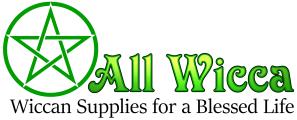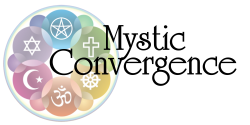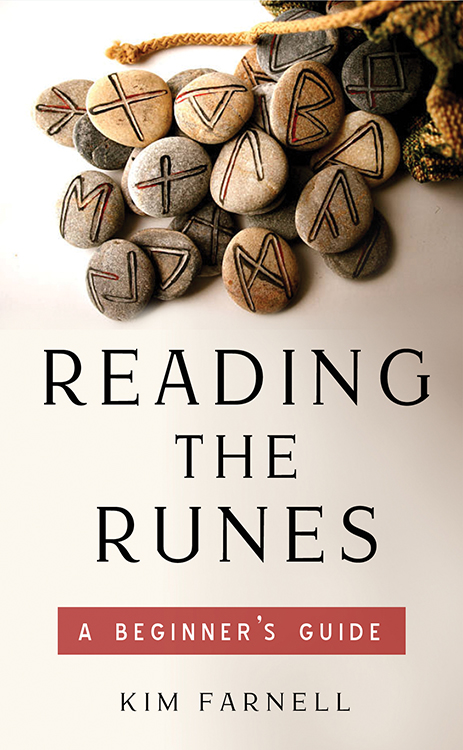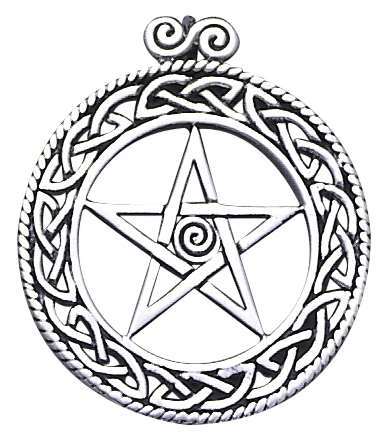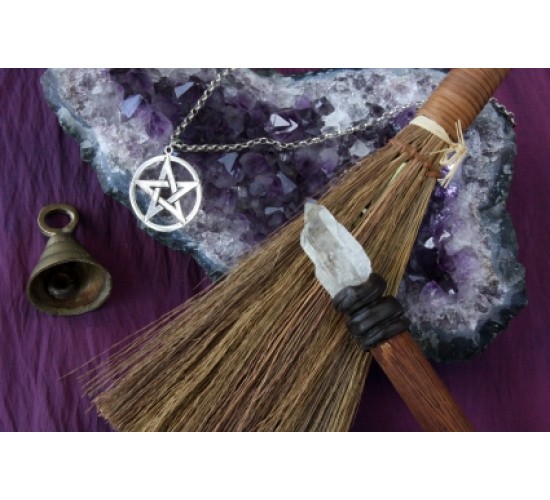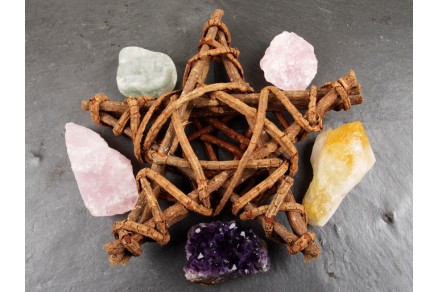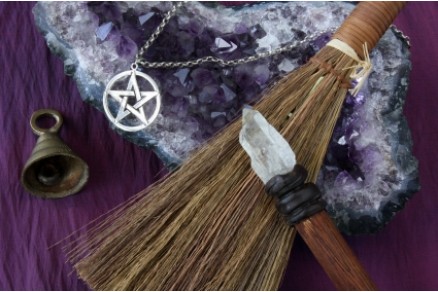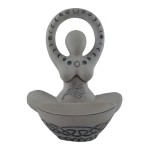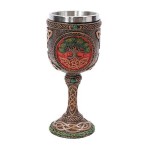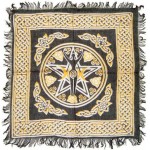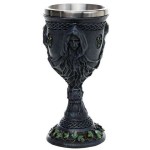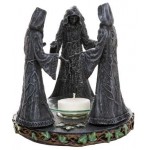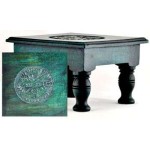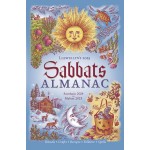The Ultimate Guide to Wiccan Altars
- 922
- 2
A Wiccan altar serves as a sacred space where practitioners can focus their energy and intentions. Whether you’re new to Wicca or simply looking for new ways to customize your altar, this guide will walk you through the key elements, various styles, layouts, and ways to personalize it. Let’s dive in!
What is a Wiccan Altar?
A Wiccan altar is more than just a surface; it’s the focal point for your spiritual work, representing your connection to the divine, the elements, and the energies you’re working with. For many, the altar is the place where rituals, spells, and meditation occur. It can be as elaborate or as simple as you like, reflecting both your personal path and your relationship with nature and the deities.
Altars serve as a place for tools, symbols, and offerings. They can be set up indoors or outdoors, and many practitioners will change their altars based on seasons, Sabbats (Wiccan holidays), or specific magical workings.
Basic Elements of a Wiccan Altar
Every Wiccan altar typically has a few essential elements that symbolize various aspects of Wiccan belief:
- Candles: Often, there are two main candles, representing the God and Goddess, or male and female energies. Some altars also feature elemental candles for Earth, Air, Fire, and Water or a central candle for your altar itself lit when using the altar as a way to signal the beginning of a working.
- Incense: Burnt to purify the space and aid in meditation or ritual, incense is a way to release your intentions to the Gods.
- Pentacle: A five-pointed star in a circle, representing the elements and the spirit. A pentacle is often placed at the center of the altar.
- Chalice: Symbolizing water and the Goddess, a chalice or goblet holds offerings like wine or water.
- Athame: A ritual knife used to direct energy, representing fire or air, depending on your tradition.
- Wand: Used to invoke or banish energies, often representing air. A magical wand can be used instead of an athame to direct energy.
- Offering Bowl: For herbs, crystals, or small offerings, a ceremonial bowl is a great focal point for your altar.
- Crystals, Herbs, and Statues: Often used to represent specific energies or deities you’re working with. Statues of your favorite God and Goddess is a wonderful reminder of your craft.
These are the basics, but remember, an altar is deeply personal. You can add or remove elements based on your own path and practices.
Altar Styles and Themes
Wiccan altars are as varied as the practitioners who use them. Here are some common altar themes:
Nature-Inspired Altar
If you feel deeply connected to nature, a nature-inspired altar might be your style. Decorate it with natural elements like stones, leaves, feathers, or flowers. You can adjust the altar to reflect the changing seasons—add fresh flowers in spring or leaves and pinecones in autumn. This type of altar celebrates Earth’s cycles and your connection to them.
Goddess-Focused Altar
A Goddess-focused altar emphasizes the divine feminine. This altar might feature statues or representations of different goddesses, a prominent chalice symbolizing the womb, and lunar symbols. You can adjust this altar to focus on one particular Goddess or celebrate the divine feminine in all forms.
Elemental Altar
An elemental altar focuses on the four elements: Earth, Air, Fire, and Water. Place representations of each element—like a bowl of salt for Earth, feathers for Air, a candle for Fire, and a bowl of water for Water—in the corresponding cardinal directions (North, East, South, West). This altar is perfect for those who want to work deeply with elemental energies.
Celtic-Inspired Altar
A Celtic-inspired altar draws from the ancient Celtic traditions. Use Celtic knots, ogham symbols, and representations of Celtic deities like Brigid or Cernunnos. Green hues, oak leaves, and stone tools add authenticity to this altar.
Ancestor Altar
Honoring those who came before is part of many Wiccan and pagan traditions. Ancestor Altars might include photographs, family mementos, and other objects that remind you of your ancestry. If your background is from a specific region such as Egyptian, African or Scottish, adding items from those cultures can be a wonderful way to connect.
Minimalist Altar
If space is limited or you prefer simplicity, a minimalist altar is ideal. You might only use a few key items like a single candle, a small pentacle, and a tiny offering bowl. The minimalist altar is great for small apartments or those who like to keep things streamlined while still connecting to their practice.
Specific Altar Layouts
There isn’t a one-size-fits-all layout for a Wiccan altar, but a few traditional designs are popular:
Traditional Wiccan Altar Layout
In a traditional layout, the God and Goddess are usually represented by candles on either side of the altar. In the center, you’ll often find the pentacle, with the elements arranged around it. Tools like the athame, wand, and chalice are placed in their respective elemental positions—typically, the athame on the right (for air/fire) and the chalice on the left (for water).
Elemental Quarter Altar
This layout aligns each of the four elements (Earth, Air, Fire, and Water) with a specific cardinal direction on your altar. The altar is arranged so that North (Earth) is at the back, East (Air) is to the right, South (Fire) is in front, and West (Water) is on the left. It’s a good option for those who focus heavily on elemental magic.
Sabbat Altar (Example: Samhain)
For Sabbats, you might choose a specific altar layout. For a Samhain altar, include symbols of death and the afterlife, like skulls, black candles, and photos of ancestors. Harvest fruits like apples and pumpkins can also be used as offerings. This altar layout focuses on honoring the dead and celebrating the Wiccan New Year.
Seasonal and Sabbat Altars
One of the beautiful things about Wiccan altars is that they can shift and change with the seasons and Sabbats. Setting up a seasonal altar is a way to honor the cycles of nature, whether it's the rebirth of spring at Ostara, the harvest of Mabon, or the introspective time of Yule. You might want to decorate your main altar or set up a secondary altar to celebrate the particular season.
For example:
- Beltane: Decorate with fresh flowers, a Maypole figure, or even a small cauldron to represent the fires of Beltane.
- Lughnasadh (Lammas): Incorporate grains, bread, and symbols of the harvest.
- Yule: Adorn your altar with evergreens, sun symbols, and candles to welcome the return of the light.
Portable and Travel Altars
If you’re someone who’s always on the go, creating a portable altar is an excellent way to stay connected to your practice. Here are some ideas:
Altoid Tin Altar
A small Altoid tin altar can fit in your bag and contain mini versions of altar tools, such as a tiny pentacle, a small vial of salt, and a tea light candle. This is great for discreet, on-the-go rituals.
Travel Altar Kit
You can also create a travel altar kit in a small pouch or box. Include essentials like a candle, a small chalice, and a piece of fabric to act as your altar cloth. Personalize it with symbols or tools that are meaningful to you.
Natural Altar
If you’re out in nature, consider creating a natural altar with found objects like stones, sticks, and leaves. You don’t always need formal tools—sometimes, nature provides all the symbolism you need.
Personalizing Your Altar
While it’s helpful to follow traditional layouts or themes, your altar should feel like a reflection of your personal path. Here are some ways to make it your own:
- Symbols: Add items that resonate with your personal beliefs or deities you work with.
- Colors: Use altar cloths in colors that align with the current season or your specific magical workings.
- Tools: Craft your own wand, decorate your athame, or make DIY incense blends that hold special meaning for you.
- Crystals: Place crystals on your altar that correspond to your intentions, such as amethyst for protection or rose quartz for love.
Remember, there’s no “right” or “wrong” way to create an altar. It’s about making a sacred space that resonates with you.
Setting up a Wiccan altar is a deeply personal and evolving practice. Whether you’re working with the elements, the deities, or the cycles of nature, your altar serves as a magical hub where your spiritual energy can flourish. Whether you prefer a minimalist setup, a seasonal shift, or an elaborate ritual space, your altar is an expression of your unique spiritual journey. Use this guide as inspiration, but let your own intuition lead the way in creating a space that feels powerful and meaningful to you.
Related Posts
5 Misconceptions about Traditional Wicca
- 1131
- 1
With the rise of eclectic, do-it-yourself Wicca, traditional Wicca quickly took a backseat. But our numbers are rising.
How to Empower your Amulet or Talisman
- 2332
- 2
A few posts ago, I talked about how an amulet or talisman was just a hunk of metal - unless you empower it. This time, I'll expand a little more on it and tell you how to empower it for your intent.
Related Products
Greenman Wood Altar Table
$62.00
